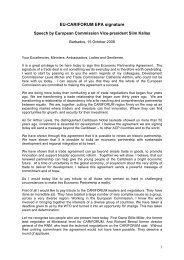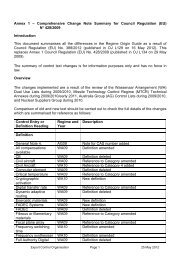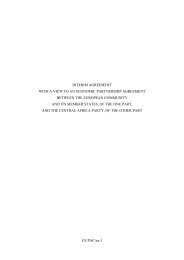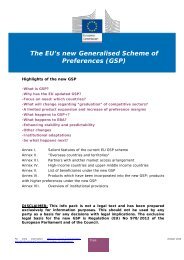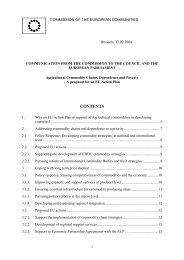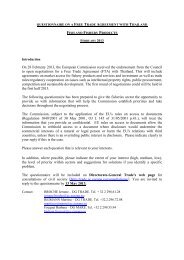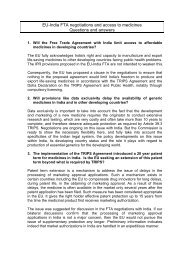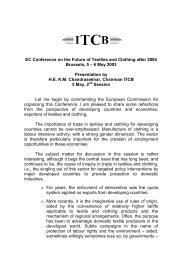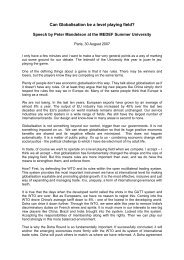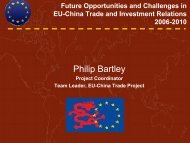Report on the Implementation of the derogation to ... - Trade Websites
Report on the Implementation of the derogation to ... - Trade Websites
Report on the Implementation of the derogation to ... - Trade Websites
Create successful ePaper yourself
Turn your PDF publications into a flip-book with our unique Google optimized e-Paper software.
Final <str<strong>on</strong>g>Report</str<strong>on</strong>g><br />
RoO Derogati<strong>on</strong> under <strong>the</strong> PACP-IEPA<br />
6.2 EU Market for Pre-cooked Frozen Tuna Loins<br />
Tuna ‘loins’ are <strong>the</strong> butchered and cleaned meat <strong>of</strong> <strong>the</strong> fish. Loining is <strong>the</strong> most labour intensive<br />
process in <strong>the</strong> processing node <strong>of</strong> <strong>the</strong> value chain in canned tuna, c<strong>on</strong>stituting around 80% <strong>of</strong> <strong>the</strong><br />
labour process in a canned tuna fac<strong>to</strong>ry. ‘Loining plants’ are based in relatively low-cost locati<strong>on</strong>s <strong>of</strong><br />
producti<strong>on</strong> in <strong>the</strong> internati<strong>on</strong>al divisi<strong>on</strong> <strong>of</strong> labour and export pre-cooked, frozen vacuum packed<br />
loins <strong>to</strong> fac<strong>to</strong>ries in higher-cost locati<strong>on</strong>s, such as Spain, where <strong>the</strong>y are defrosted and inserted in<strong>to</strong><br />
<strong>the</strong> canned tuna producti<strong>on</strong> process. Figure 6.1 sketches a generic value chain in canned tuna. EU<br />
trade preferences are critical <strong>to</strong> <strong>the</strong> logic <strong>of</strong> loining (i.e. <strong>the</strong>y enter duty free under (Interim) EPAs<br />
with <strong>the</strong> ACP and under <strong>the</strong> GSP+ scheme). The EU loin market will c<strong>on</strong>tinue as l<strong>on</strong>g as EU-based<br />
canneries are protected by a 24% MFN duty. In additi<strong>on</strong>, in <strong>the</strong> face <strong>of</strong> competiti<strong>on</strong> from imported<br />
canned tuna, EU-based processors may need <strong>to</strong> rely more heavily <strong>on</strong> imported loins in order <strong>to</strong> limit<br />
costs and remain competitive.<br />
Figure 6.1 Schematic value chain in canned tuna<br />
In c<strong>on</strong>trast <strong>to</strong> <strong>the</strong> EU market for imported canned tuna, <strong>the</strong> volume <strong>of</strong> loin imports c<strong>on</strong>tinued <strong>to</strong><br />
grow in 2009 with a slight 7% drop-<strong>of</strong>f in 2010 (Figure 6.2). In <strong>the</strong> ten-year period 2001-10, <strong>the</strong><br />
volume <strong>of</strong> <strong>the</strong> EU imported loin market doubled, while in value terms it grew by two and a half<br />
times. The proporti<strong>on</strong>ally higher growth in value over volume reflects <strong>the</strong> very low prices <strong>of</strong> raw<br />
material in 1999 and through <strong>the</strong> early 2000s. (See Secti<strong>on</strong> 6.7.4 below for a discussi<strong>on</strong> <strong>of</strong> <strong>the</strong> impact<br />
<strong>of</strong> <strong>the</strong> derogati<strong>on</strong> <strong>on</strong> PNG’s share <strong>of</strong> <strong>the</strong> EU import market for tuna loins.)<br />
Spain is <strong>the</strong> largest importer <strong>of</strong> loins, followed by Italy. France is in decline and Portugal has <strong>on</strong>ly<br />
ever been a relatively minor market. This is because Spain is <strong>the</strong> largest producer <strong>of</strong> canned tuna in<br />
<strong>the</strong> EU by a very large margin (see discussi<strong>on</strong> and data in Secti<strong>on</strong> 6.3.1 <strong>on</strong> intra-EU producti<strong>on</strong> and<br />
trade). However, unlike France and Italy which rely predominantly <strong>on</strong> imported loins, Spain still uses<br />
whole round tuna as its main source <strong>of</strong> tuna raw material supply. 251<br />
251 Campling et al. 2007: 317-18.<br />
Linpico s.a.r.l. Page 125




